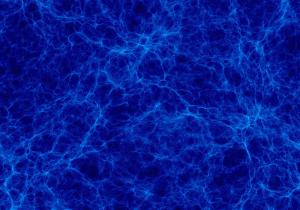Blog
SIMPle Dark Matter
2 November 2014
 The Marenostrum Numerical Cosmology Project
The Marenostrum Numerical Cosmology ProjectDark matter remains an enigma of modern cosmology. We have indirect evidence of its existence, and even some evidence of its characteristics, but we have yet to detect dark matter directly. This puts us in a kind of middle ground where there’s enough evidence to support dark matter, but not enough to define it, which is the perfect playground for theorists to try new ideas. This week in Physical Review Letters, just such a new idea has been presented.1
The most popular model for dark matter is the WIMP model, or Weakly Interacting Massive Particles. They are so-named because they would have a much larger mass than protons, but would only interact through the weak nuclear force. This means they wouldn’t interact with light much (hence they would be “dark”), and they wouldn’t interact with each other so strongly that they can’t create a halo of dark matter around galaxies. But even weakly interacting particles would occasionally interact with regular matter. Given current observations, there should be about 5 times more dark matter than regular matter in the universe, so we should be able to detect some interactions directly. However despite several ongoing searches, there’s been no clear evidence of it.
So this new paper proposes a new model, known as Strongly Interacting Massive Particles, or SIMPs. In this model, dark matter particles have about a tenth the mass of a proton, but they strongly interact with both regular matter and themselves. That might seem contradictory to the nature of dark matter, but so long as they interact in the right way, it could all work out. Basically, SIMPs would tend to clump to mimic more massive WIMPs, and they would interact weakly with light, as dark matter should. But because of their smaller mass, they would interact with electrons more strongly than nuclei. Since dark matter searches have focused on nuclei interactions, this would explain why we haven’t detected them.
In the paper the authors show that the SIMP model agrees with current observations of dark matter, and it shows where future experiments could support or invalidate the idea. But based upon current evidence it is no more compelling than the popular WIMP models. Still, at this point we need new ideas like this one. Dark matter has been frustratingly difficult to pin down.
Hochberg, Yonit, et al. “Model for thermal relic dark matter of strongly interacting massive particles.” Physical Review Letters 115.2 (2015): 021301. ↩︎